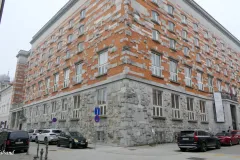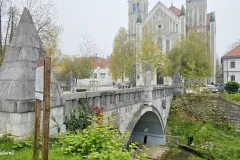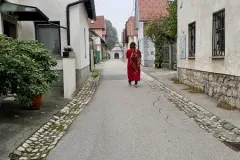Jože Plečnik reshaped Ljubljana between the World Wars, crafting a timeless vision that defined Slovenia’s capital and its national identity.
The UNESCO World Heritage List includes over a thousand properties. They have outstanding universal value and are all part of the world’s cultural and natural heritage.
Official facts
- Official title: The works of Jože Plečnik in Ljubljana – Human Centred Urban Design
- Countries: Slovenia
- Date of Inscription: 2021
- Category: Cultural
UNESCO’s World Heritage Centre’s short description of site no. 1643:
The works Jože Plečnik carried in Ljubljana between World War I and World War II present an example of a human centred urban design that successively changed the identity of the city following the dissolution of the Austro-Hungarian Empire, when it changed from a provincial city into the symbolic capital of the Slovenian people.
The architect Jože Plečnik contributed to this transformation with his personal, profoundly human vision for the city, based on an architectural dialogue with the older city while serving the needs of emerging modern 20th century society.
The property consists of a series of public spaces (squares, parks, streets, promenades, bridges) and public institutions (national library, churches, markets, funerary complex) that were sensitively integrated into the pre-existing urban, natural and cultural context and contributed to the city’s new identity.
This highly contextual and human-scale urbanistic approach, as well as Plečnik’s distinctive architectural idiom, stand apart from the other predominant modernist principles of his time.
It is an exceptional case of creating public spaces, buildings and green areas according to the vision of a single architect within a limited time, the limited space of an existing city, and with relatively limited resources.
My visit
Jože Plečnik (1872-1957) was born and raised in Ljubljana, and spent much of his adult years in Vienna and Prague. He eventually returned to Ljubljana from the early 1930’s. Here local and national authorities commissioned him to transform the newly formed capital into a modern city.
Plečnik did this by combining modernist ideas from different architectural movements. Most notable is the Vienna Secession style of architecture (think of Art Nouveau). He also drew lessons from Baroque and Byzantine traditions in his homeland, as well as early eighteenth century Viennese architecture. In addition he paid reverence to classical ideals in his works.
The Slovenian architect is not the first architect to appear on UNESCO’s World Heritage List. Sandalsand has visited other UNESCO sites dedicated to individual architects. Look up posts relating to Victor Horta in Brussels, the Stoclet House in the same city, and also Antoni Gaudí in Barcelona.
One might suspect there is an obligation inside this international organisation to promote distinguished individuals within the profession of architects. Possible conspiracy theories aside, I lean towards the negative conclusion that works of individuals should not be awarded prizes of “world heritage”.
In the case of Plečnik, only his works in Ljubljana are included. None stand out as iconic in their own right. In addition he only managed to blend his pieces of architecture into a mixture of several other trends and the city at large. So what is this all about? It is hard to see, at least from a layman’s perspective.
This World Heritage Site consists of structures in and around Ljubljana, and the rest of this text will take you there.
Green axis
One often presents Plečnik’s works as being lined up along, as well as being the very part of, two axes. The water axis follows the river running through Ljubljana while the green, or land, axis follows city streets.
If you look into my map at the bottom of this article and zoom into Ljubljana, you will find the green line. The map line is strictly speaking more extended that the original. I wanted to include a couple of Plečnik sites and start with the Trnovo Bridge in the south. From here you should deviate from the straight line in order to look up the Roman Wall.
Ljubljana used to be a fortified Roman town and parts of the Roman wall has been preserved. Plečnik designed a pyramid as a gate through the wall.
Return to the straight line and walk past an alllotment garden as well as some segments of traditional small house architecture until you reach a square with the Monument to the French Illyrian Province.
Pleasant and interesting sights, but neither of these are Plečnik’s works. From here you will follow the land axis on Vegova Street from the National and University Library, to the Congress Square and Zvezda Park. All of these bear Plečnik’s stamp.
The sorting of the images below is chronological (date and time taken) and not (necessarily) according to the sequence described above.
Plečnik’s Water Promenade
This is the second of two axes in Ljubljana, part of the urban design of “Plečnik’s Ljubljana”. The water axis follows the river Ljublanica’s western river course (it splits in two in the northeast). Both banks of this river course are included and there is a promenade on either side.
The Sluice Gate (Plečnik) is defined as the upper end of this water axis, to the northeast. From here the river winds in a large half-circle around a hilltop with a castle on top. The other end of this promenade is at the confluence of Ljubljanica’s river courses, after a distance of about 2.5 km.
In between you will find a number of bridges designed by Plečnik, most notably the Triple Bridge on Prešeren Square, the central square of Ljubljana. The nearby long market halls and the Central Market layout are also works by him.
Zale
Žale Central Cemetery is the largest and most important cemetery in Ljubljana. Joze Plečnik designed the monumental entrance and surrounding buildings near it.
Church of St. Francis of Assisi
The Church of St. Francis of Assisi in the district of Siska was completed in 1928, and represents the first major project in Plečnik’s plan for Ljubljana. You will find the location in the map below.
St. Michael’s Church
The Church of St. Michael in Crna Vas, a short drive out of Ljubljana is a Roman Catholic Church. This work was complete in 1939. This church was kind of more interesting, or at least fascinating to me.
Read more
Find more articles from Slovenia on Sandalsand. Read what others have said about this heritage site in Ljubljana. And look into Google Arts and Culture’s story.
Browse to the PREVIOUS or NEXT post in this series.
A map
In the map below, you will find UNESCO signs inside the city of Ljubljana as well as outside. Zoom in and move around in the map as you like. When you do, find the two coloured lines showing the designated axes related to Plečnik, the green and the blue line.
The blue line is what UNESCO calls the Water Axis. It follows the river from the Sluice bridge in the north to the confluence of the two Ljubljanica rivers in the south. The green line runs from the Kongresni Trg in the north to Trnovo Bridge in the south.
Apart from this the map is full of other attractions in Ljubljana. It is a very pleasant city. In addition there are three day trips to other parts of the country. Some of these attractions include World Heritage Sites.
















































